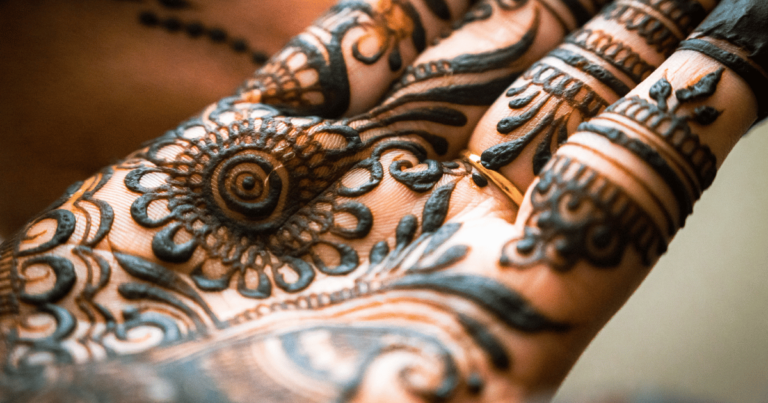Mehndi, often referred to as henna, isn’t just an art—it’s a celebration of culture, tradition, and beauty. From adorning brides on their special day to being a symbol of joy during festive events, mehndi designs have held significance for centuries. Whether you’re a bride-to-be, a mehndi enthusiast, or a wedding planner looking for inspiration, this guide will walk you through everything you need to know about mehndi designs, including their history, popular styles, and expert tips.
Table of Contents
What is Mehndi?
Mehndi is a traditional form of body art using a paste made from the powdered leaves of the henna plant. Typically applied to the hands and feet, the intricate designs symbolize positivity, love, and prosperity. Mehndi plays a prominent role in weddings, religious functions, and cultural celebrations across South Asia, the Middle East, and North Africa.
Popular Styles of Mehndi Designs
The beauty of mehndi lies in its endless creativity and versatility. Below are some of the most popular mehndi styles around the world:
1. Indian Mehndi Designs
Characterized by intricate patterns and densely packed elements like paisleys, florals, and peacocks, Indian mehndi often stretches far up the arms and legs. These designs also include elements like the bride and groom’s figures or religious motifs.
2. Arabic Mehndi Designs
Arabic mehndi designs focus on bold, floral patterns with negative space as their hallmark. Unlike Indian styles, they lean toward simpler, more elegant designs that use thick lines and emphasize symmetry.
3. Pakistani Mehndi Designs
Pakistani mehndi often combines elements of both Indian and Arabic designs. These intricate patterns include a mix of geometric shapes, flowers, and spiritual symbols, making them highly detailed and versatile.
4. Moroccan Mehndi Designs
Inspired by tribal art, Moroccan mehndi features bold geometric shapes, symmetrical lines, and dots. These designs are simpler and more minimalistic compared to the ornate styles of India and Pakistan.
5. Modern and Fusion Mehndi Designs
Today’s fashion-forward generation embraces custom styles that are a mix of traditional and contemporary elements. Think minimalistic patterns, Western motifs, or even glitter-loaded designs to add that extra sparkle!
Comparison Table of Mehndi Styles
| Style | Key Features | Best For | Cultural Origin |
| Indian | Intricate paisleys, florals, and peacocks | Bridal mehndi, elaborate ceremonies | India |
| Arabic | Bold flower motifs with negative spaces | Casual, festive occasions | Middle East |
| Pakistani | Mix of Indian and Arabic, detailed geometric | Religious and wedding events | Pakistan |
| Moroccan | Tribal patterns with bold geometric designs | Unique and minimalist looks | North Africa |
| Modern/Fusion | Custom motifs, minimalistic or glitter accents | Fashion-forward events | Global Influence |
Tips for Choosing the Perfect Mehndi Design
When it comes to selecting the ideal mehndi design, here are some expert tips to keep in mind:
i. Understand the Occasion
For brides, opt for intricate Indian or Pakistani mehndi with storytelling elements. For festive events, try Arabic or modern designs for a minimalist yet impactful look.
ii. Know Your Personal Style
Do you prefer intricate details or bold, simple patterns? Your design should reflect your personality while complementing your outfit and event theme.
iii. Consider Skin Tone
Darker mehndi stains often stand out more prominently on lighter skin tones, while thicker designs with negative spaces might pop better on medium to darker tones.
iv. Book a Professional Mehndi Artist
If you’re preparing for a wedding or major event, seek the expertise of a seasoned mehndi artist who can execute complex patterns and ensure a deep stain.
v. Prepare Your Skin
Prep your skin by washing and exfoliating the areas where the mehndi will be applied. This helps the henna adhere better and ensures a darker, longer-lasting stain.
Caring for Your Mehndi
To achieve the darkest and longest-lasting mehndi stain, follow these tips:
- Avoid Water Immediately After Application: Don’t wash your hands or feet for at least 12 hours after application.
- Apply Lemon and Sugar Mix: After the paste has dried, dab a mixture of lemon juice and sugar on the design to help set the henna.
- Keep It Warm: Henna darkens with heat, so keep your hands warm after applying.
- Allow It to Fall Off Naturally: Resist the urge to remove the dried paste by washing. Instead, gently scrape it off to allow the stain to develop fully.
Mehndi FAQs
1. How Long Does Mehndi Last?
Mehndi stains typically last 1-2 weeks, with the color fading naturally over time.
2. Can I Make My Mehndi Stain Darker?
Yes! Keeping the paste on longer (around 6-8 hours), applying a lemon-sugar mix, and avoiding water immediately after removal can help darken the stain.
3. Can Pregnant Women Apply Mehndi?
Absolutely! Mehndi is considered safe for all, including pregnant women, as it is made from natural henna leaves.
4. What’s the Best Mehndi for Sensitive Skin?
For sensitive skin, use pure, chemical-free henna to avoid irritation. Avoid black henna, as it often contains harmful chemicals like PPD.
5. When Should I Apply Mehndi Before an Event?
It’s best to apply mehndi 1-2 days before your event so the stain has time to mature into its darkest shade.
Celebrate Culture and Beauty with Mehndi
Mehndi is more than just a temporary tattoo—it’s a deep-rooted tradition that tells stories and brings joy. Whether you’re a bride preparing for your big day or a cultural enthusiast exploring this timeless art, there’s a mehndi design out there for you.
If you’re planning a wedding or event and need help finding the perfect mehndi artist, feel free to reach out! Together, let’s celebrate the beauty and heritage of this age-old tradition.

